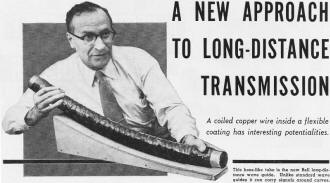|
This story in the April 1955
issue of Radio & Television News might be the first public disclosure of Bell
Telephone Laboratories' flexible waveguide design. Operating at 50 GHz, the
new waveguide will replace hundreds of existing coaxial cables that can each carry
only 600 telephone channels and two television channels. It can also increase the
distance between amplifiers from 12 miles to 50 miles. Construction consists of
a hollow flexible tube lined with a spiral winding of copper wire. Incidentally,
the lower cutoff frequency for
circular waveguide with a 2-inch diameter, as
reported here, works out to around 1.8 GHz. I was skeptical about the claim
of operation at 50 GHz since that kind of spectrum was the domain of laboratories
back in the day, not commercially deployed systems. 2 GHz was doable, so the
new waveguide accommodated existing technology as well as future expansion. One
thought that occurred to me is that the story mentions coaxial cable bundles that
included spares for backup in case one or two went bad. The waveguide represents
a single point failure with no redundancy unless a dual run was made for each installation.
A New Approach to Long-Distance Transmission

This hose-like tube is the new Bell long-distance wave guide.
Unlike standard wave qui des it can carry signals around curves.
A coiled copper wire inside a flexible coating has interesting potentialities.
Bell Telephone Laboratories has developed a new and radically different medium
for transmitting television and telephone conversations over long distances. The
new medium, a long-distance wave guide, is radically different from modern cable
or radio relay systems in that it uses a hollow metallic tube roughly two inches
in diameter.
Scientists at the Lab believe that this new unit may someday carry tens of thousands
of cross-country telephone conversations and hundreds of television programs simultaneously.
By contrast, the top capacity for the most modern coaxial cable systems is 1860
two-way telephone conversations or 600 telephone conversations and two TV programs
simultaneously on a pair of coaxial tubes. Modern coaxial cables have eight such
tubes, two of which are kept as spares for emergencies.

Length of the experimental wave guide. It is of flexible copper
and approximately 2 inches in diameter. Carrier frequency is 50,000 mc.

A Bell Labs engineer tests transmission through the new wave
guides of various sizes. The 2-inch diameter was found to be the best.
Wave guides made of solid metal tubing have been widely used for some time for
short distances. It would be possible to use these solid metal tubes for long distances
if they were perfectly straight, but this is impractical. The new long-distance
wave guide is also a hollow tube but it is constructed of a thin copper wire, very
tightly coiled and wrapped inside a flexible outer coating which holds the coiled
wire in place. This type need not be straight and can actually carry signals around
corners.
Although this new form of transmission is still in the experimental stage, a
recent long-distance test was made at Holmdel in a copper pipe 500 feet long. Engineers
bounced signals back and forth in the tube for distances of 40 miles. They calculated
that in comparison, the same waves could have traveled only 12 miles in a coaxial
cable with the same loss in strength.
The new transmission system operates even above the "super high" band of 30,000
mc. The carrier frequency for the new wave guide is about 50,000 megacycles.
A major difference between transmission through the new wave guide and through
previous systems is that the higher the frequency in the wave guide, the less the
loss through attenuation. This is exactly the reverse of other forms of transmission.
Beyond the prospect of an improved transmission with the long-distance wave guide
is the possibility of learning how to use tiny wavelengths on the order of one millimeter,
about 125th of an inch. If this should become possible, the wave guide of the future
may be no thicker than a fountain pen and still carry tens of thousands of telephone
messages.
As a result of this experimental work, the engineers hope to use the new wave
guide in a variety of ways. One such application might be with a heavy protective
coating so that the hollow tubes can be run underground which would put them out
of sight and out of the reach of the elements. This latter consideration offers
possibilities of reduced maintenance cost and even better service.
Posted April 8, 2019
|












